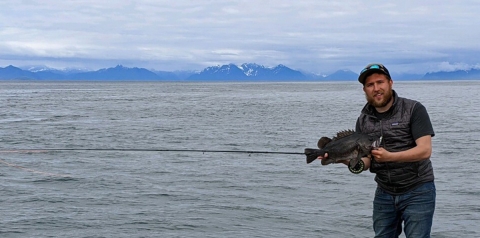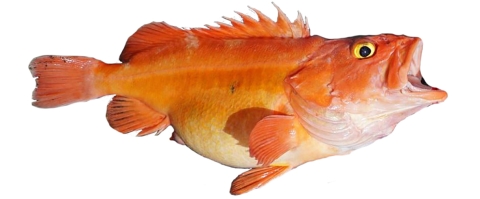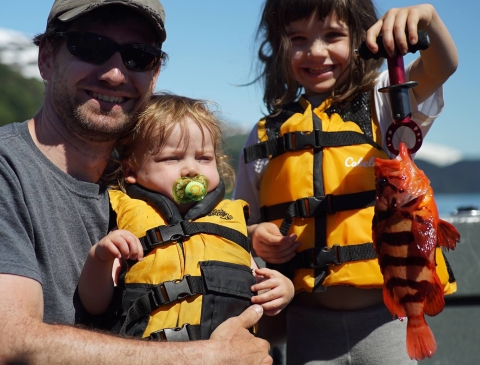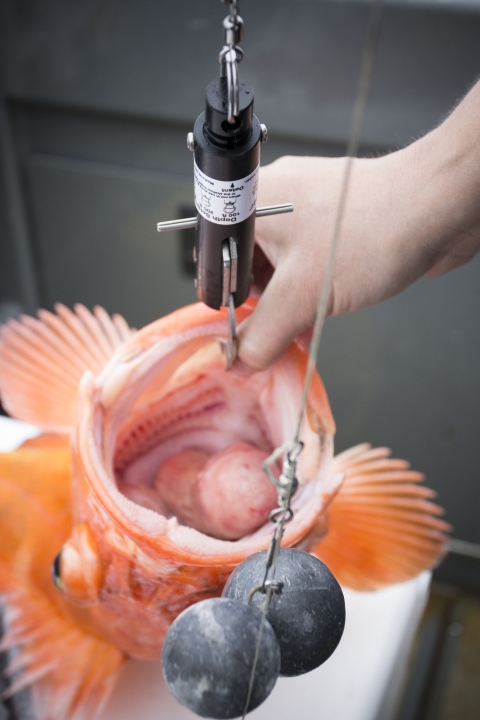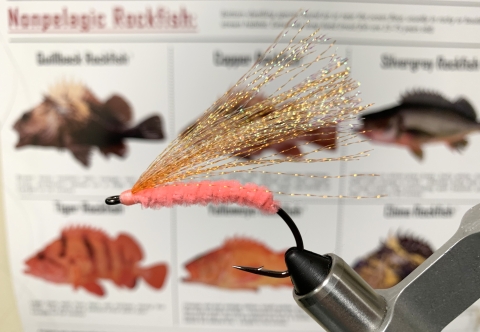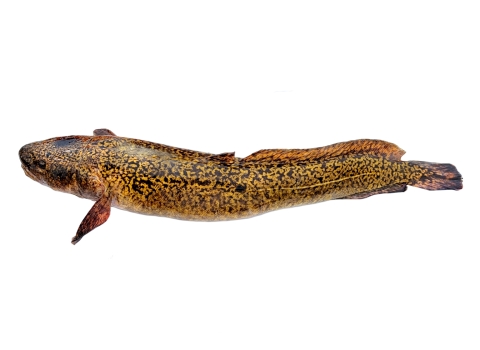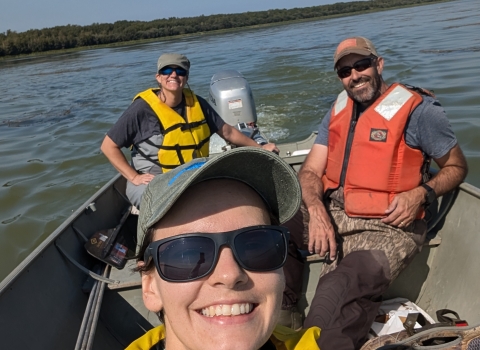Rockfish are in the Sebastes family and there are over 30 different species in Alaska’s waters. They tend to like rocks!
Rockfish are amazing. Reproduction-wise, for instance, they actually copulate and give live birth. In Alaska, they’re either full of eggs or starting to release larvae anywhere from April to July. They give birth to a lot of babies. The larvae are swept away and the survivors settle on the ocean floor, hiding in rocks, kelp, and eelgrass.
Pelagic VS Nonpelagic Rockfish
Pelagic typically means relating to the open sea. Pelagic species—like Black Rockfish — are typically your mid-water schooling species group. They’re found throughout the water column, typically close to rocky structures, but can also be found up at the surface. They tend to congregate more than nonpelagics and aren’t usually as big. Their lifespan is long (7-30 years old on average), but not as long as the nonpelagics.
Typically, species in the pelagic assemblage are the black or darker-colored fish. There’s a few exceptions — some are kind of a yellowish or olive color. And they look similar to a bass.
Then you have your nonpelagics. These are more of a bottom-dwelling type—like your your Yelloweye Rockfish. They’re found near the ocean floor in rocky or boulder strung habitat. They tend to be in smaller schools and keep to themselves. They hide more than pelagic species.
Some of them are really-deep-dwelling — like the Shortraker and Rougheye. And they’re longer-lived (15–75 years old on average).
“The oldest documented Yelloweye was close to 120 years old.”
Common non-pelagics include Yelloweye, Quillbacks, Copper, Silvergray, China, and Tiger Rockfish. A lot of the non-pelagics are more colorful than the pelagics—they’re commonly reddish, orangish, or yellowish in color.
Barotrauma
Rockfish have a “closed” swim bladder that can’t vent. As they’re brought to the surface from deep water, the water pressure decreases and the air in their swim bladder expands and can’t escape. Injuries caused by bringing rockfish up from deep water are collectively called barotrauma.
“Sometimes their stomach pops out of the mouth, their eyes bulge out…If it’s a gravid female, you’ll see eggs coming out. All of these injuries—it’s called barotrauma.”
A swim bladder is a special organ that most fishes have that allows them to stay neutrally buoyant in the water column.
Deepwater Release
Since 2020, all vessels sport fishing in the saltwaters of Alaska must have a functioning deepwater release mechanism on board, and all rockfish not harvested must be released at depth of capture, or at a depth of 100 feet.
What we’ve found through studies over more than a decade is that if you release a rockfish deeper than 100 feet, it can survive. It’s mind blowing to me, because they just look awful when you catch them.
One option is to modify your jig. Typically you’d put a little wiggle tail on the end and fish with that. But instead, tie your line to the bend in the hook. Attach the hook (with barb removed) into the mouth of the fish, open the bail on your reel, and drop the fish back down to the bottom.
There’s another product that has a pressure sensor and a little clip to attach to the lip of the fish. It’s weighted, and when it gets down to a preset depth the clip will open and the fish can swim away.
Another option that I really like using is a milk crate—I turn it upside down so the bottom has the opening and I tie a 100+ foot line to the top, and put this contraption over the fish. It sinks the fish down and the you retrieve just retrieve the crate. We know they survive deep water release because we did some studies on Yelloweye — we tagged and then recaptured them over three years.
What are some fishing tips for catching rockfish?
There’s a good chance you’re going to catch a rockfish while targeting halibut and lingcod. Technique-wise, you’re going to be jigging.
I typically fish for rockfish the same way I fish for lingcod. I look for rocky areas—you can get into a lot of species on steep rock walls. I like to drop my line down, then jig up and down very close to the bottom. I don’t typically anchor up, but rather drift. The amount of weight you’ll need depends on what the tides and wind are doing—you might need six ounces or you might need 24. I typically use light gear, like something I’d use for salmon fishing. You don’t need a heavy duty halibut rod, because rockfish are smaller and you’ll want to feel them when they hit.
A lot of people use bait, but I love using lures and jigs. My favorite is a shrimp fly. I like it up on my line, maybe a foot and a half and then have a jig on the very bottom. So you’ve got two different things going on.
So you just using super heavy sinking line for the shrimp fly? Are you actually using a fly rod?
I’m not using a fly rod but you can when the Black Rockfish are on the surface. The shrimp fly is just a little hook with a little bit of material on it. And it’s just coming off a loop off the side of your main line.
What about gear entanglement around the rocks?
When I’m jigging, if I start to feel I’m coming up on something, reel up a little bit to stay off the bottom. I like to use a heavy, braided line. I can move the boat around a little bit and try and get the gear back. It’s just the risk you take fishing around rocky areas. You will occasionally get snagged and lose gear.
Eating Rockfish
I’m a very partial to rock fish tacos. Having kids, I also like to make little nuggets. I like to eat them fresh, or as soon as possible, because they don’t freeze nearly as well as halibut and lingcod. You can also cook the fish whole with some limes and cilantro and sesame oil and stuff and bake it in the oven. Then you’re getting as much meat as you possibly can off the fish.
Safety Tip
Always wear a life jacket when you’re fishing on open water regardless of your swimming abilities. Many marinas and boat launches have jackets that are free to borrow. Alaska law requires any child under 13 years old to wear a U.S. Coast Guard–approved personal floatation device at all times while on the deck of a vessel or in an open vessel.
Additional Reading & Watching
Rockfish Conservation and Deepwater Release (ADF&G)
How to use a deepwater release device — release of a yelloweye rockfish (ADF&G)
Is Barotrauma keeping you up? Try Getting Down With Recompression!
Rockfish: Matrotrophically Viviparous (ADF&G)
New episodes of Fish of the Week! every Monday!
In Alaska we are shared stewards of world renowned natural resources and our nation’s last true wild places. Our hope is that each generation has the opportunity to live with, live from, discover and enjoy the wildness of this awe-inspiring land and the people who love and depend on it. We honor, thank, and celebrate the whole community — individuals, Tribes, the State of Alaska, sister agencies, fish enthusiasts, scientists, and others — who have elevated our understanding and love, as people and professionals, of all the fish.
Follow us: Facebook Twitter Apple Podcasts
